Magpie
lab constructor
    
Posts: 5939
Registered: 1-11-2003
Location: USA
Member Is Offline
Mood: Chemistry: the subtle science.
|
|
Preparation of p-Toluidine
I have prepared p-toluidine with 12.2g of p-nitrotoluene using Vogel’s (3rd ed) “Method A” for aniline, at 0.44 scale. Adjustments were made
for the differing molecular weights of the respective precursors, nitrobenzene and nitrotoluene. Method A utilizes tin/HCl as reducing agent.
The reaction and subsequent steam distillation were conducted in a 250mL RBF. I could tell that the p-nitrotoluene had all been reduced as I could no
longer detect its pleasant almond-like smell. This was replaced with the out-house smell of p-toluidine. The melted p-toluidine is shown below as a
pale yellow oil floating on top of the water:
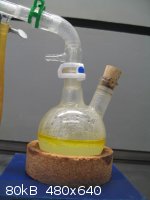
p-toluidine in steam distillate
My pot residue consisted of stannous/stannic hydroxides that didn’t dissolve, as shown below.
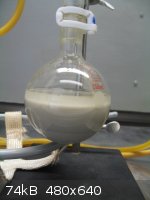
steam distillation pot residue
The Vogel procedure says that this hydroxide should dissolve after enough NaOH is added. Testing 1mL of the gray slurry I found that it would not
dissolve even after 4mL of aqueous NaOH was added. Therefore, I did not add any more NaOH. I’ve since seen other procedures that indicate that
these hydroxides do not necessarily dissolve.
I substituted DCM for ether to extract the p-toluidine from the steam distillate. It is shown here being dried over potassium carbonate:
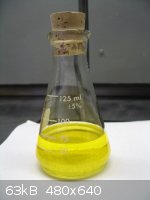
DCM extract of steam distillate, drying
The dried extract was distilled to remove the DCM. The p-toluidine pot residue was crystallized by air drying. The crystals were contaminated with a
reddish-brown colored substance. The weight of these crude crystals was 8.5g, indicating a 90% yield at this point.
A recrystallization was done using 85% ethanol. Three successive crystal batches were harvested. This provided only limited purification.
The melting point for these crystals was ~ 35°C. The literature value is 43.8°C.
Noting that the procedure on the LambdaSyn (a German chemistry forum) website specified using petroleum ether as a solvent for recrystallization I
decided to give this a try. The ACS pet ether that I used had a boiling point range of 30°-60°C.
Here I did three recrystallizations. The crystals form quickly as very thin plates, like fish scales. These recrystallizations were tedious and I
lost considerable product due to all the handling. I did obtain two small purified batches. The first batch was 1.6g of apparently quite pure
p-toluidine as it had a mp of 44-45°C, agreeing with literature values. Even this material, however, was gray and not the pure white I was expecting.
See photo below.
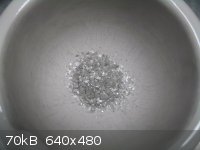
p-toluidine after 3rd recrystallization in pet ether
The 2nd batch of crystals was 1.4g of less pure material, having a mp of 40.5°C.
Taking the total weight of product as 3.0g, my yield therefore dropped to 32%.
Discussion
p-Toluidine is a solid at room temperature. I therefore warmed it to melting before making transfers. It did tend to clog the condenser during steam
distillation as indicated by Vogel. But this was easily cleared by cutting back on the condenser cooling water flow, as suggested by Vogel.
The p-toluidine was difficult to purify. The crystallization with 85% ethanol did not work well. I attribute this to a poor solubility vs
temperature curve. I washed the crystals on the Buchner funnel using ice-cold water. The sticky flake crystals made this washing difficult.
Conclusions
I do like the use of tin/HCl for the reduction of nitro-aromatics. It works the best of several methods I have tried. I have not had good luck using
powdered iron and it makes a real mess of my glassware/sink, and makes cleanup tedious.
I think the root problem in using crystallization is that the p-toluidine is very soluble in just about every common solvent. And making things worse
the solubility vs temperature curve is relatively flat. In retrospect in might be better to purify p-toluidine by vacuum distillation, as recommended
by Armarego & Chai in “Purification of Laboratory Chemicals.”
Questions/comments/suggestions are welcomed.
The single most important condition for a successful synthesis is good mixing - Nicodem
|
|
|
Paddywhacker
Hazard to Others
  
Posts: 478
Registered: 28-2-2009
Member Is Offline
Mood: No Mood
|
|
Thanks for the writeup. Aromatic amines are one of my least favourite class of compound, and nitro reductions are a bitch to workup. I always thought
that the stannous hydroxide was soluble in NaOH to form a stannate or stannite.
It is easy to speculate about alternative purifications. I have purified aniline by vacuum distillation, and that went well, but I disliked cleaning
the glassware afterwards. Maybe dissolving the amine in aqueous acid and extracting with DCM would remove the coloured impurity, then basify and
re-extract for the amine. But purified aniline starts to darken all on its own and p-toluidine may be the same.
Edit: alanine -> aniline
[Edited on 27-3-2014 by Paddywhacker]
|
|
|
Chemosynthesis
International Hazard
    
Posts: 1071
Registered: 26-9-2013
Member Is Offline
Mood: No Mood
|
|
Agreed! That's great of you to write up for us.
|
|
|
organicchemist25
Hazard to Others
  
Posts: 136
Registered: 12-2-2014
Member Is Offline
Mood: No Mood
|
|
Thanks! This is a very thorough write-up and the pics are much appreciated!
I am wanting to perform the exact same experiment. I have a huge, new pressure cooker for generating the steam. I have the fitting I am going to tap
the existing hole with to accept my 3/8" ID hose.
Is that a good way to generate my steam? It is a 41.5 Qt size, so it should provide steam for a while.
Do I need anything in-between for condensate removal? or just straight over to my inlet connection?
[Edited on 27-3-2014 by organicchemist25]
|
|
|
Magpie
lab constructor
    
Posts: 5939
Registered: 1-11-2003
Location: USA
Member Is Offline
Mood: Chemistry: the subtle science.
|
|
Quote: Originally posted by organicchemist25  | I have a huge, new pressure cooker for generating the steam. I have the fitting I am going to tap the existing hole with to accept my 3/8" ID hose.
Is that a good way to generate my steam? It is a 41.5 Qt size, so it should provide steam for a while.
Do I need anything in-between for condensate removal? or just straight over to my inlet connection?
|
Yes, a pressure cooker makes a fine steam generator. I have a 4-qt size which is adequate when I fill it about 1/2 full of water. On occasion I have
had to stop and refill it, but this is rare. I heat it on a hot-plate, setting the power to about 65% using a Variac.
Yes, a steam trap intermediate is very useful to collect condensate. I use a 500mL sep funnel as shown in the picture below. In this picture I am
injecting steam and heating with a mantle simultaneously.
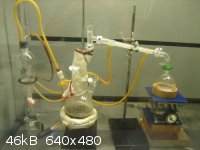
[Edited on 27-3-2014 by Magpie]
The single most important condition for a successful synthesis is good mixing - Nicodem
|
|
|
Dr.Bob
International Hazard
    
Posts: 2658
Registered: 26-1-2011
Location: USA - NC
Member Is Offline
Mood: No Mood
|
|
That is a great experimental writeup. I use aromatic amines often and make many from nitro groups, so I appreciate the pain that they can be. But
it is one of the most reliable reactions to do, unlike some reactions that are very sensitive to substrate changes or air and water. My favorite
method is H2 and Pd/C, but I have also done tin/iron methods as well as hydrazine in ethanol with Raney Nickel, which works on many nitro groups.
That can be a very good method also. But a 90% yield is good. You might have some salts in with the initial product as well, I often find that
some salts can carry over in that type of distillation. The vacuum distillation idea is good, but distillations work best with large amounts of
material, very hard to distill 8.5g of anything without significant loses, but if you have 100g, you can often recover 90g or more. But evaporating
any reaction to dryness is a bad idea, better to distill 3/4 off and then cool it down, add more material and start it back, doing several small
batches, or distill 4 batches 75% and then combine the residues to try to recover the rest.
|
|
|
organicchemist25
Hazard to Others
  
Posts: 136
Registered: 12-2-2014
Member Is Offline
Mood: No Mood
|
|
ok, nice. I see exactly what you did  Ill use a sep funnel too. Ingenious. Thanks
so much! Ill use a sep funnel too. Ingenious. Thanks
so much!
Oh, and you said you were heating simultaneously. So, do you keep the temp in the flask as close as possible to 100C to be consistent with the steam
coming over? Or would it depend on the compound one is trying to separate? Higher temp for more viscous material? I know water/steam will only be
100C?, but could/would you pass it through the mixture in the flask with it being of higher temperature ? or keep everything 100C
Thanks
|
|
|
Magpie
lab constructor
    
Posts: 5939
Registered: 1-11-2003
Location: USA
Member Is Offline
Mood: Chemistry: the subtle science.
|
|
You are welcome.
There are two types of steam distillation. One uses injected steam like we are discussing and is called the live steam method. The other
uses external heat such as a mantle and is called the direct method. What you use depends on the situation at hand.
In the picture I happen to be using both. I must have felt that the added heat was needed, so I added the mantle. This may have been just for
pre-heating the pot contents, I can't remember. Use of the mantle also minimizes the amount of water added via steam condensation.
For the p-toluidine I just used the live steam method.
[Edited on 28-3-2014 by Magpie]
[Edited on 28-3-2014 by Magpie]
The single most important condition for a successful synthesis is good mixing - Nicodem
|
|
|
AbbyS
Harmless

Posts: 2
Registered: 2-6-2015
Member Is Offline
Mood: No Mood
|
|
Quote: Originally posted by Magpie  |
p-Toluidine is a solid at room temperature. I therefore warmed it to melting before making transfers. It did tend to clog the condenser during steam
distillation as indicated by Vogel. But this was easily cleared by cutting back on the condenser cooling water flow, as suggested by Vogel.
|
Hi, hope I'm not too late with my question  I'm currently doing p-toluidyne in my
class and I wanted to ask you about the extraction. As you said - the product was crystalizing in the condenser, so did it cause any traubles later
on? I'll be performing extraction using Diethyl ether I'm currently doing p-toluidyne in my
class and I wanted to ask you about the extraction. As you said - the product was crystalizing in the condenser, so did it cause any traubles later
on? I'll be performing extraction using Diethyl ether
|
|
|
Magpie
lab constructor
    
Posts: 5939
Registered: 1-11-2003
Location: USA
Member Is Offline
Mood: Chemistry: the subtle science.
|
|
Quote: Originally posted by AbbyS  | Quote: Originally posted by Magpie  |
p-Toluidine is a solid at room temperature. I therefore warmed it to melting before making transfers. It did tend to clog the condenser during steam
distillation as indicated by Vogel. But this was easily cleared by cutting back on the condenser cooling water flow, as suggested by Vogel.
|
Hi, hope I'm not too late with my question  I'm currently doing p-toluidyne in my
class and I wanted to ask you about the extraction. As you said - the product was crystalizing in the condenser, so did it cause any traubles later
on? I'll be performing extraction using Diethyl ether I'm currently doing p-toluidyne in my
class and I wanted to ask you about the extraction. As you said - the product was crystalizing in the condenser, so did it cause any traubles later
on? I'll be performing extraction using Diethyl ether
|
No problems other than what I described. Maybe I don't understand your question.
The single most important condition for a successful synthesis is good mixing - Nicodem
|
|
|
AbbyS
Harmless

Posts: 2
Registered: 2-6-2015
Member Is Offline
Mood: No Mood
|
|
I'm just worried if it starts crystalyzing during extraction or evaporation, both have temperature below 40 degrees. Sometimes I have the worst luck

|
|
|
ChemPlayer_
Harmless

Posts: 28
Registered: 21-6-2015
Location: Asia
Member Is Offline
Mood: Synthetic
|
|
I recently performed this exact same reaction inspired by Vogel (and Magpie) using ortho-nitrotoluene.
Some observations I made which might be useful for the overall body of knowledge:
1. Like Magpie's observation (contrary to Vogel) I got a very cloudy white/grey cloudy solution with a lot of solids suspended in it after sodium
hydroxide addition (the claim is that this all dissolves). This didn't seem to affect anything negatively during the steam distillation phase though.
2. I experimented using direct steam distillation (no external generation - just using water boiling in the reaction flask). This worked fine although
the flask had to be topped up occasionally with water to reduce some bumping in the flask. This was efficient and fairly quick as well - if anything
perhaps slightly faster than using external steam.
3. DCM was a useful solvent for washing glassware and solids in order to reduce mechanical losses, then pooling the washes, evaporating and adding
this to the crude product.
4. This is by far the best aromatic nitro reduction when I compare to using Iron, or reagents such as hydrosulfides or zinc metal with formic acid (in
the latter I believe significant tolidine is also generated as a side product).
Video and full write up here for reference: https://www.youtube.com/watch?v=dBETk-rFa4c
|
|
|
Magpie
lab constructor
    
Posts: 5939
Registered: 1-11-2003
Location: USA
Member Is Offline
Mood: Chemistry: the subtle science.
|
|
Very nice! I can see that you are now also a fan of tin/HCl and DCM (vs ether).
The single most important condition for a successful synthesis is good mixing - Nicodem
|
|
|
smaerd
International Hazard
    
Posts: 1262
Registered: 23-1-2010
Member Is Offline
Mood: hmm...
|
|
Nice work MagPie.
Chem Player you make great videos!
I've always preferred the Tin/HCl reduction. Only when I did it I used the SnCl2 made via refluxing tin shot in HCl until complete dissolution. Then
again that was for a diazonium salt not a nitro compound. But yes I have to agree iron is awful, makes magnetic stirring impossible.
Maybe I'll give this synthesis a try sometime.
|
|
|
ChemPlayer_
Harmless

Posts: 28
Registered: 21-6-2015
Location: Asia
Member Is Offline
Mood: Synthetic
|
|
Magpie, correct you are; DCM is my favourite 'general purpose' solvent and I far prefer using it to ether for obvious reasons. Recycling (distilling)
is also quick and easy.
Now one question which has been on my mind is - could a grignard reagent be prepared in DCM? You could envisage a risk of the DCM being deprotonated
and potentially even an equilibirum of some sort being set up with 'DCM-Grignard' being involved too. I honestly have no idea but I feel an experiment
coming on soon...
|
|
|
Magpie
lab constructor
    
Posts: 5939
Registered: 1-11-2003
Location: USA
Member Is Offline
Mood: Chemistry: the subtle science.
|
|
I think this question has been discussed before on this forum. I'm not sure where to find it, however.
diethyl ether supposedly has a special property of solvating Mg that DCM does not have, IIRC.
An experiment may well be in order.
The single most important condition for a successful synthesis is good mixing - Nicodem
|
|
|
ChemPlayer_
Harmless

Posts: 28
Registered: 21-6-2015
Location: Asia
Member Is Offline
Mood: Synthetic
|
|
Although it's off-topic I'll follow up here with the result of my DCM Grignard test.
Placed a few grams of dried magnesium in a small oven dried flask with 20ml of DCM which had been dried by adding spatula of phosphorus pentoxide and
left for a few days in a sealed bottle (then decanted and filtered through cotton wool). 2 grams of methyl iodide were introduced (about 1ml) and a
very tiny crystal of iodine.
A few hours later the iodine turned from initial purple to a red colour in solution but that was it. No bubbles, no 'dishwater'.
A control experiment using exactly the same reagents but ether as the solvent (not even sodium dried) worked fine.
I have to conclude that either DCM doesn't work or there's extra trickery involved (or trace amounts of P2O5 mess it up).
|
|
|
Pumukli
National Hazard
   
Posts: 686
Registered: 2-3-2014
Location: EU
Member Is Offline
Mood: No Mood
|
|
For Grignard ethers are required because as Magpie said they can make complexes with the Mg-part of the reagent and this ether-complex is important.
Reportedly N,N-dimethylaniline works as well, although I don't have any references handy.
You may try it with DCM mixed with ether, this way you may save on ether but the solvent recovery may become complicated.
|
|
|
Metacelsus
International Hazard
    
Posts: 2531
Registered: 26-12-2012
Location: Boston, MA
Member Is Offline
Mood: Double, double, toil and trouble
|
|
Besides, the magnesium could react with the dichloromethane.
|
|
|
ChemPlayer_
Harmless

Posts: 28
Registered: 21-6-2015
Location: Asia
Member Is Offline
Mood: Synthetic
|
|
Thanks - all makes sense. It would be interesting to have see this article to because apparently this refers to Grignards in DCM.
Modification of the Grignard reaction
D. J. Nelson , R. DiFrancesco and D. Petters
J. Chem. Educ., 1977, 54 (10), p 648
|
|
|